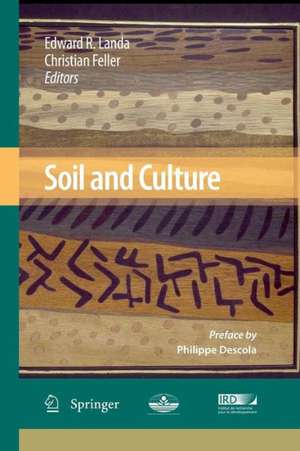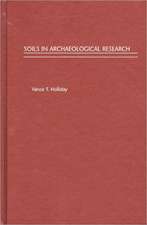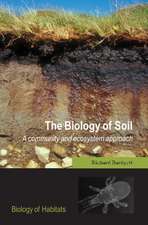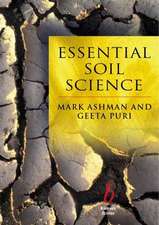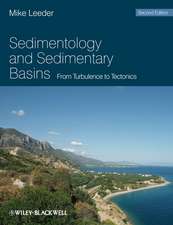Soil and Culture
Editat de Edward R. Landa, Christian Felleren Limba Engleză Paperback – 2 noi 2014
Soil and Culture explores the perception of soil in ancient, traditional, and modern societies. It looks at the visual arts (painting, textiles, sculpture, architecture, film, comics and stamps), prose & poetry, religion, philosophy, anthropology, archaeology, wine production, health & diet, and disease & warfare.
Soil and Culture explores high culture and popular culture—from the paintings of Hieronymus Bosch to the films of Steve McQueen. It looks at ancient societies and contemporary artists. Contributors from a variety of disciplines delve into the mind of Carl Jung and the bellies of soil eaters, and explore Chinese paintings, African mud cloths, Mayan rituals, Japanese films, French comic strips, and Russian poetry.
| Toate formatele și edițiile | Preț | Express |
|---|---|---|
| Paperback (1) | 1228.62 lei 6-8 săpt. | |
| SPRINGER NETHERLANDS – 2 noi 2014 | 1228.62 lei 6-8 săpt. | |
| Hardback (1) | 1233.06 lei 6-8 săpt. | |
| SPRINGER NETHERLANDS – dec 2009 | 1233.06 lei 6-8 săpt. |
Preț: 1228.62 lei
Preț vechi: 1498.31 lei
-18% Nou
Puncte Express: 1843
Preț estimativ în valută:
235.10€ • 256.40$ • 198.24£
235.10€ • 256.40$ • 198.24£
Carte tipărită la comandă
Livrare economică 24 aprilie-08 mai
Preluare comenzi: 021 569.72.76
Specificații
ISBN-13: 9789400791183
ISBN-10: 9400791186
Pagini: 544
Ilustrații: XX, 524 p.
Dimensiuni: 155 x 235 x 29 mm
Greutate: 0.76 kg
Ediția:2009
Editura: SPRINGER NETHERLANDS
Colecția Springer
Locul publicării:Dordrecht, Netherlands
ISBN-10: 9400791186
Pagini: 544
Ilustrații: XX, 524 p.
Dimensiuni: 155 x 235 x 29 mm
Greutate: 0.76 kg
Ediția:2009
Editura: SPRINGER NETHERLANDS
Colecția Springer
Locul publicării:Dordrecht, Netherlands
Public țintă
ResearchCuprins
Soil and the Visual Arts.- The Representation of Soil in the Western Art: From Genesis to Pedogenesis.- Deforestation and Erosion Captured in Historical Art of the Pearl River Delta Region, China.- Transcendental Aspects of Soil in Contemporary Visual Arts.- Merging Horizons—Soil Science and Soil Art.- Soil Colors, Pigments and Clays in Paintings.- In a Supporting Role: Soil and the Cinema.- Under my feet—Soil presence and perspectives in the work of four contemporary visual artists.- Dig Deeper.- Creating Fiber Art with Soil and Rust.- Soil, Subsoil, Priming and Architectural Design.- Art by the Ground.- Soil and Soul: Literature and Philosophy.- To Join the Real and the Mental Place: The Written Earth.- “Pochveniks”—“The Poets of The Soil”: The Geological School of 20th Century Poetry in Leningrad, USSR (St. Petersburg, Russia).- The Soil Scientist’s Hidden Beloved: Archetypal Images and Emotions in the Scientist’s Relationship with Soil.- Comprehending Soil within the Context of the Land Community.- Core Samples of the Sublime—On the Aesthetics of Dirt.- Perspectives on Soil by Indigenous and Ancient Cultures.- European Religious Cultivation of the Soil.- “Rock – Stone” and “Soil – Earth”: Indigenous Views of Soil Formation and Soil Fertility in the West Indies.- Mobilizing Farmers’ Knowledge of the Soil.- Ancient Maya Perceptions of Soil, Land, and Earth.- The Soil Memory: Case Study of a Protohistoric Archaeological Site in Senegal.- Soil and Health.- Soils and Geomedicine: Trace Elements.- Do Pedo-Epidemiological Systems Exist?.- “Earth Eaters”: Ancient and Modern Perspectives on Human Geophagy.- Soil – the dark side and the light side.- Soil and Warfare.- Yellow Sands and Penguins: The Soil of “The Great Escape”.- Soilsand Soil Pioneers on Stamps.- Soil in Comic Strips and Cartoons.- Soils and Terroir Expression in Wines.
Recenzii
From the reviews
The lent ritual "Remember that thou art dust, and unto dust thou shalt return" takes a totally different meaning in this remarkable book. In spite of its crucial importance, the set of scientific disciplines covered by the name "soil science" does not benefit from the public recognition it should have. Although physics and biology fire the imagination of artists, no one considers soil science as a source of decisive insights into our earthly existence. No one, that is, apart from the billions of people for whom the soil possesses a life-and-death salience. This unique gathering of ethnographic materials, state-of-the-art scientific research, and original art forms, arrives just at the moment when the whole planet is rediscovering what it means to say that we are earthlings. (Bruno Latour, Sciences Po, Professor at "Sciences Po Paris" (School of Political Sciences) University, Paris, France)
“Soil and culture, a collection of essays by a variety of authors, fills this gap by illustrating the full suite of ways in which soils affect human society. … compiling fascinating information or providing deep insight. Soil and art is one of the book’s main themes. … gives a face to what that means, and shows how a blending of the natural sciences, social sciences and humanities can provide deep insights into humanity’s relationship with nature. It is a lovely book.” (Joshua Schimel, Nature Geoscience, Vol. 301 (3), 2010)
"The hard-bound, multi-authored, 28-chapter book addresses social, cultural, philosophical, and aesthetic aspects of world soils. Thematic topics are amply illustrated by visuals (124 photographs in vivid colors), graphs (22), tables (9) and numerous references (900). All authors and co-authors, component and world class professionals, have compiled and synthesized the available knowledge on this important topic.[...] This book highlights another important, but until recently little recognized function ofsoil: its cultural, artistic, philosophical, medicinal and religious functions. Therefore, this book explores and explains cultural, aesthetical and artistic functions of soil in ancient, traditional and modern societies. It incorporates a range of topics such as visual art (e.g., paintings, sculpture), written verses (i.e., poetry), religious themes (scriptures), anthropological scenes (paintings), and archaeological issues (ancient/historical ruins and records). Therefore, the book chapters are contributed by not only the soil scientists but also by poets, studio artists, gallery owners, farmers, philosophers, historians, geographers and geologists and those interested in human health and nutrition. [...] It is an excellent reference material on several emerging themes that cut across several disciplines." (Rattan Lal, Director, Carbon Management and Sequestration Center, The Ohio State University, Columbus, OH, USA)
“Landa (hydrologist, USGS) and Feller … have compiled 28 original essays on the study of soil from anthropological, historical, and cultural perspectives. … intended audience includes social geographers and general researchers as well as those interested in the lighter side of soils. … The chapters are written for a general academic audience, and include citations, graphics, notes, and (when appropriate) pictures. … should be in every academic library that supports programs in geography and soils. Summing Up: Highly recommended. Lower-division undergraduates through researchers/faculty.” (I. D. Gordon, Choice, Vol. 47 (11), July, 2010)
The lent ritual "Remember that thou art dust, and unto dust thou shalt return" takes a totally different meaning in this remarkable book. In spite of its crucial importance, the set of scientific disciplines covered by the name "soil science" does not benefit from the public recognition it should have. Although physics and biology fire the imagination of artists, no one considers soil science as a source of decisive insights into our earthly existence. No one, that is, apart from the billions of people for whom the soil possesses a life-and-death salience. This unique gathering of ethnographic materials, state-of-the-art scientific research, and original art forms, arrives just at the moment when the whole planet is rediscovering what it means to say that we are earthlings. (Bruno Latour, Sciences Po, Professor at "Sciences Po Paris" (School of Political Sciences) University, Paris, France)
“Soil and culture, a collection of essays by a variety of authors, fills this gap by illustrating the full suite of ways in which soils affect human society. … compiling fascinating information or providing deep insight. Soil and art is one of the book’s main themes. … gives a face to what that means, and shows how a blending of the natural sciences, social sciences and humanities can provide deep insights into humanity’s relationship with nature. It is a lovely book.” (Joshua Schimel, Nature Geoscience, Vol. 301 (3), 2010)
"The hard-bound, multi-authored, 28-chapter book addresses social, cultural, philosophical, and aesthetic aspects of world soils. Thematic topics are amply illustrated by visuals (124 photographs in vivid colors), graphs (22), tables (9) and numerous references (900). All authors and co-authors, component and world class professionals, have compiled and synthesized the available knowledge on this important topic.[...] This book highlights another important, but until recently little recognized function ofsoil: its cultural, artistic, philosophical, medicinal and religious functions. Therefore, this book explores and explains cultural, aesthetical and artistic functions of soil in ancient, traditional and modern societies. It incorporates a range of topics such as visual art (e.g., paintings, sculpture), written verses (i.e., poetry), religious themes (scriptures), anthropological scenes (paintings), and archaeological issues (ancient/historical ruins and records). Therefore, the book chapters are contributed by not only the soil scientists but also by poets, studio artists, gallery owners, farmers, philosophers, historians, geographers and geologists and those interested in human health and nutrition. [...] It is an excellent reference material on several emerging themes that cut across several disciplines." (Rattan Lal, Director, Carbon Management and Sequestration Center, The Ohio State University, Columbus, OH, USA)
“Landa (hydrologist, USGS) and Feller … have compiled 28 original essays on the study of soil from anthropological, historical, and cultural perspectives. … intended audience includes social geographers and general researchers as well as those interested in the lighter side of soils. … The chapters are written for a general academic audience, and include citations, graphics, notes, and (when appropriate) pictures. … should be in every academic library that supports programs in geography and soils. Summing Up: Highly recommended. Lower-division undergraduates through researchers/faculty.” (I. D. Gordon, Choice, Vol. 47 (11), July, 2010)
Textul de pe ultima copertă
SOIL —beneath our feet
—food and fiber
—ashes to ashes, dust to dust
—dirt
Soil has been called the final frontier of environmental research. The critical role of soil in biogeochemical processes is tied to its properties and place—porous, structured, and spatially variable, it serves as a conduit, buffer, and transformer of water, solutes and gases. Yet what is complex, life-giving, and sacred to some, is ordinary, even ugly, to others. This is the enigma that is soil.
Soil and Culture explores the perception of soil in ancient, traditional, and modern societies. It looks at the visual arts (painting, textiles, sculpture, architecture, film, comics and stamps), prose & poetry, religion, philosophy, anthropology, archaeology, wine production, health & diet, and disease & warfare.
Soil and Culture explores high culture and popular culture—from the paintings of Hieronymus Bosch to the films of Steve McQueen. It looks at ancient societies and contemporary artists. Contributors from a variety of disciplines delve into the mind of Carl Jung and the bellies of soil eaters, and explore Chinese paintings, African mud cloths, Mayan rituals, Japanese films, French comic strips, and Russian poetry.
—food and fiber
—ashes to ashes, dust to dust
—dirt
Soil has been called the final frontier of environmental research. The critical role of soil in biogeochemical processes is tied to its properties and place—porous, structured, and spatially variable, it serves as a conduit, buffer, and transformer of water, solutes and gases. Yet what is complex, life-giving, and sacred to some, is ordinary, even ugly, to others. This is the enigma that is soil.
Soil and Culture explores the perception of soil in ancient, traditional, and modern societies. It looks at the visual arts (painting, textiles, sculpture, architecture, film, comics and stamps), prose & poetry, religion, philosophy, anthropology, archaeology, wine production, health & diet, and disease & warfare.
Soil and Culture explores high culture and popular culture—from the paintings of Hieronymus Bosch to the films of Steve McQueen. It looks at ancient societies and contemporary artists. Contributors from a variety of disciplines delve into the mind of Carl Jung and the bellies of soil eaters, and explore Chinese paintings, African mud cloths, Mayan rituals, Japanese films, French comic strips, and Russian poetry.
Caracteristici
This volume explores the link between science and art on an earth and environmental science level Soil science is expanding its reach to a broader audience and using the non-traditional material contained in this book to serve as a bridge to potential new audiences The interdisciplinary character of this book is reflective of "environmental studies" programs - a field blending science and non-science faculties at many campuses in North America The content, scope and diversity of this volume's contributors are unique, including poets, studio artists, gallery owners, farmers, philosophers, historians, geographers, geologists and soil scientists A comprehensive volume with content understandable to both scientists and non-scientists alike without diluting the interest-level for either audience
